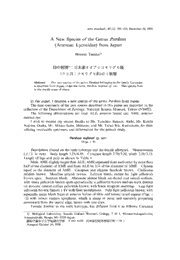
A New Species of the Genus Pardosa(Araneae: Lycosidae) from Japan. PDF
Preview A New Species of the Genus Pardosa(Araneae: Lycosidae) from Japan.
Acta arachnol., 47 (2): 101-103, December 30, 1998 A New Species of the Genus Pardosa (Araneae: Lycosidae) from Japan Hozumi Tanakal> 田中穂積1):日 本産オオアシコモリグモ属 (クモ目:コ モ リグモ科)の1新 種 Abstract One new species of the genus Pardosa belonging to the family Lycosidae is described from Japan, under the name, Pardosa nojimai sp. nov. This species lives in the mouth areas of rivers. In this paper, I describe a new species of the genus Pardosa from Japan. The type specimens of the new species described in this paper are deposited in the collection of the Department of Zoology, National Science Museum, Tokyo (NSMT). The following abbreviations are used: ALE, anterior lateral eye; AME, anterior median eye. I wish to express my sincere thanks to Mr. Yasuhiro Itakura, Aichi, Mr. Koichi Nojima, Osaka, Mr. Mitsuo Saito, Shimane, and Mr. Teruo Irie, Kumamoto, for their offering invaluable specimens and information for the present study. Pardosa nojimai sp. nov. (Figs. 1-4) Descriptions (based on the male holotype and the female allotype). Measurements (d~ / - in mm). Body length 5.25/6.50. Carapace length 2.70/3.20, width 2.20/2.75. Length of legs and palp as shown in Table 1. Male: AME slightly larger than ALE; AME separated from each other by more than half of the diameter of AME and from ALE by 1 /4 of the diameter of AME. Clypeus equal to the diameter of AME. Carapace and clypeus brackish brown. Chelicerae reddish brown. Maxillae greyish brown. Labium black, except for light yellowish brown apex. Sternum black. Abdomen almost black on dorsal and lateral surfaces, with many yellowish brown spots sporadically; a yellowish brown median mark distinct on dorsum; ventral surface yellowish brown, with black irregular markings. Legs light yellowish brown; femora I-IV with faint annulations. Palp light yellowish brown, with especially many black hairs at anterior halves of tibia and tarsus; tarsal organs (Figs. 1 -2) with robust median apophysis , which is sharp at point and narrowly projecting downward from the lateral edge; tarsus with one claw. Female: Similar to the male holotype, but different from it as follows: Carapace 1) Biological Laboratory, Sonoda Gakuen Women's College, 7-29-1, Minami-tsukaguchi-cho, Amagasaki-shi, Hyogo, 661-8520 Japan. T 661-8520 J;~~IrIjD~T 7-29-1 Accepted October 16, 1998 102 H. Tanaka Figs. 1-4. Pardosa nojimai sp. nov. 1, Male palp, ventral view; 2, same, retrolateral view; 3, epigynum, ventral view; 4, female genitalia, dorsal view. (Scales: 0.2 mm.) Table 1. Length of legs and palp of Pardosa no] imai sp. nov. (6/; ~in mm). dark brown, with a yellowish brown median band, which is widened in front. Clypeus light yellowish brown. Maxillae light yellowish brown. Sternum black, with a nar- row light yellowish line on median part. Legs and palp reddish brown; femora I-IV with distinct annulations. Epigynum having a distinctive, anchor-shaped septum as in Fig. 3; spermathecae not paralleled (Fig. 4). Variation. Male. Body length 4.45-5.25 mm; carapace length 2.40-2.75 mm, width 1.90-2.20 mm; abdomen length 2.05-2.55 mm, width 1.35-1.70 mm. In some individ- uals carapace with a faint yellowish brown median band widened in front. Female. Body length 5.80-8.35 mm; carapace length 2.90-3.00 mm, width 2.25- 2.50 mm; abdomen length 2.80-5.35 mm, width 1.85-3.50 mm. Type series. Holotype: c~, Hirai, Okayama-city, Okayama Pref., 17. V. 1994, K. Nojima leg. (NSMT-Ar 4146). Allotype: -, same data as for the holotype (NSMT-Ar 4147). Other specimens examined. 1 --, Tenryu river, Ryuyou-cho, Shizuoka Pref., 2. VI. 1994, Y.Itakura leg.; 1 d~,2 --,Yodogawa, Yodogawa-ku, Osaka-city, Osaka Pref., 19. V. 1998, H. Tanaka leg.; 7 d~, 11 ~, same locality as for the holotype, 15. V. 1998, K. A New Species of Genus Pardosa 103 Nojima leg.; 27 d, 48 --, same locality as for the holotype, 15. V. 1998, H. Tanaka leg.; 3 6, Miyasu, Higashiakae-cho, Yasugi-city, Shimane Pref., 23. V. 1997, M. Saito leg.; 1 --, Kawagichi-cho, Kumamoto-city, Kumamoto Pref., 22. III. 1998, H. Suenaga and K. Yoshinaga leg. Distribution. Japan (Honshu and Kyushu). Remarks. This species is similar to the species of Pardosa laura complex, but can be easily separated from them by the male palp with one claw instead of two and by the female epigynum with anchor-shaped septum (Fig. 3). Etymology. The species is dedicated to Mr. Koichi Nojima, Osaka, who collected the type specimens. 摘 要 日本産のオオアシコモ リグモ属(コ モ リグモ科)の1新 種を ・Pα76!b5αη(》伽α∫sp.nov. カコウコモリグモ(新 称)と 命名 し記載した.本 種は河口付近 に生息する.
